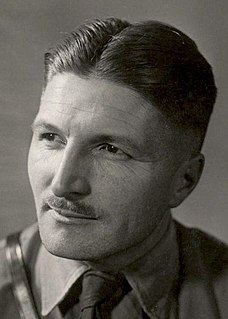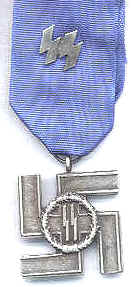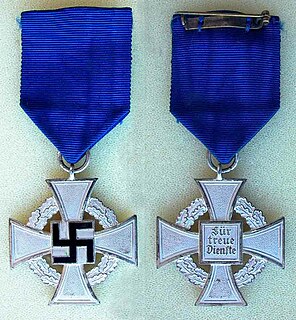Sources
- Angolia, John (1989). For Führer and Fatherland: Political & Civil Awards of the Third Reich. R. James Bender Publishing. ISBN 978-0912138169.
A Service award was awarded by a country to a soldier or civilian for long service. It is comparable to a service medal but can be awarded to civilians as well as soldiers.
The Nazi Party (NSDAP) awarded the NSDAP-Dienstauszeichnung (Nazi Party Long Service Award) for 25 (Gold), 15 (Silver) and 10 (Bronze) years' service, while the SS awarded a separate SS-Dienstauszeichnung for 4, 8, 12 and 25 years of service.
The Wehrmacht awarded the 4-class Dienstauszeichnung for 4 (silver medal); 12 (gold medal); 18 (silver cross) and 25 (gold cross) years' service, with oak leaves on the first class for 40 years.
Similarly there was a Loyal Service Medal for active members of the German police or "an administrator" in the police service known as the Polizei Dienstauszeichnung . In addition there was a Service Award for Public Work.
From 1849 it awarded a cross made out of cannon-metal for military service.

Gustav Schwarzenegger was an Austrian police chief, postal inspector, and a military police officer. He was the father of Arnold Schwarzenegger.
Awards and Decorations of Nazi Germany were military, political and civilian decorations that were bestowed between 1923 and 1945, first by the Nazi Party and later the state of Nazi Germany.
This is a list of words, terms, concepts and slogans of Nazi Germany used in the historiography covering the Nazi regime. Some words were coined by Adolf Hitler and other Nazi Party members. Other words and concepts were borrowed and appropriated, and other terms were already in use during the Weimar Republic. Finally, some are taken from Germany's cultural tradition.

Joseph Berchtold was an early senior Nazi Party member and a co-founder of both the Sturmabteilung (SA) and Schutzstaffel (SS).

Karl August Hanke was an official of the Nazi Party (NSDAP) during its rule over Germany and served as the fifth and last Reichsführer of the Schutzstaffel (SS). He also served as Gauleiter of Gau Lower Silesia from 1941 to 1945 and as Oberpräsident of the Prussian Province of Lower Silesia. Captured on 6 May 1945, he was shot and killed by Czech communists on 8 June, after the war had ended.

The War Order of the German Cross, normally abbreviated to the German Cross or Deutsches Kreuz, was instituted by Adolf Hitler on 28 September 1941. It was awarded in two divisions: in gold for repeated acts of bravery or military leadership; and in silver for distinguished non-combat war service. The German Cross in Gold ranked higher than the Iron Cross First Class but below the Knight's Cross of the Iron Cross, while the German Cross in Silver ranked higher than the War Merit Cross First Class with Swords but below the Knight's Cross of the War Merit Cross with Swords.

Karl Fiehler was a German Nazi Party (NSDAP) official and Mayor of Munich from 1933 until 1945. He was an early member of the Nazi Party having joined in 1920. In 1933, he became a Reichsleiter in the party and was a member of the Reichstag. In March of 1933, he was appointed Mayor of Munich and held that post until the end of World War II in Europe. During his time as mayor, Fiehler was zealously anti-Semitic and saw to it that the Jewish population of the city was persecuted. After the war in January 1949, Fiehler was sentenced to two years in a labour camp, but the sentence was suspended given the previous three-and-a-half years of detention he had already served.

Political decorations of the Nazi Party were medals and awards issued by the National Socialist German Workers Party (NSDAP) between 1920 and 1945. Political awards were authorized for wear on any paramilitary uniform of Nazi Germany, as well as civilian attire, but were generally discouraged on Wehrmacht military uniforms. The Waffen-SS freely wore both political awards and military decorations on their uniforms.

Johann Baptist Albin Rauter was a high-ranking Austrian-born SS functionary and war criminal during the Nazi era. He was the highest SS and Police Leader in the occupied Netherlands and therefore the leading security and police officer there during the period of 1940–1945. Rauter reported directly to the Nazi SS chief, Heinrich Himmler, and also to the Nazi governor of the Netherlands, Arthur Seyss-Inquart. After World War II, he was convicted in the Netherlands of crimes against humanity and executed by firing squad.

SS Long Service Awards were given in grades of four years, eight years, twelve years, and twenty-five years. The four and eight-year service awards were in the form of circular medals while the 12 and 25-year service awards were in the form of swastikas. The SS service awards were designed in Munich by Professor Karl Diebitsch. The awards varied in design depending on the length of service of the recipient.

The Civil Service Faithful Service Medal was a Nazi Germany medal of honor that was founded on 30 January 1938, in two grades, to reward civilians and military in the employ of the German public services for long and faithful service.

Karl Wahl was the Nazi Gauleiter of Gau Swabia from the Gau inception in 1928 until the collapse of Nazi Germany in 1945. After the war, Wahl spent 3½ years in jail before being released in 1949. In 1954, he became the first former Gauleiter to publish his autobiography.
Josef Spacil was a German Nazi SS-Standartenführer (colonel), a Befehlshaber der Sicherheitspolizei und des SD Niederlande, an SS-Wirtschafter beim Höheren SS- und Polizeiführer Russland-Süd and the Chef der Amtsgruppe II in RSHA. In 1945 he was involved with the disposal of Nazi gold in the Bavarian Alps.

Hans Benno Hüttig was a German SS functionary and Nazi concentration camp commandant.

Johann Niemann was a German SS and Holocaust perpetrator who was deputy commandant of Sobibor extermination camp during Operation Reinhard. He also served as a Leichenverbrenner at Grafeneck, Brandenburg, and Bernburg during the Aktion T4, the SS "euthanasia" program. Niemann was killed during the Sobibor prisoner uprising in 1943.

The Wehrmacht Long Service Award was a military service decoration of Nazi Germany issued for satisfactory completion of a number of years in military service.

The Nazi Party Long Service Award, sometimes called the NSDAP Long Service Award, was a political award in the form of a badge of the Nazi Party.

The Police Long Service Award (Germany) (Polizei-Dienstauszeichnung) was a long service medal awarded to active members of the German Police during the era of Nazi Germany as a political award. Professor Richard Klein designed the awards, which varied slightly in design depending on the length of service of the recipient.
The following is a comprehensive list of orders, decorations, and medals bestowed by the Sovereign Military Order of Malta, both in the present-day and historically.

Paul Fritz Wiemann, Rektor and NSDAP Ortsgruppenamtsleiter was an official of the Nazi Party (NSDAP). He served as Amtsleiter and Propagandaleiter in the city of Eilenburg from 1938 to 1945.